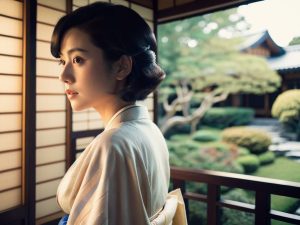What comes to mind when you think of the Edo period? Perhaps samurai, kimonos, temples, or old streets. While these are certainly defining images of the era, the Edo period was also one of the most unique times in Japanese history. Spanning approximately 260 years without major wars, the era fostered the development of commercial activities and a rich, vibrant culture among commoners. Many of the technologies and practices that form the foundation of modern Japan were also born during this time. This article explores Edo culture, technology, and everyday life, infused with fascinating facts you’ll be itching to share! By the end, you may find the Edo period surprisingly relatable and closer to modern life than you imagined.
The Edo Period: Understanding the Shogun and the Bakufu System

The Edo period lasted from 1603 to 1868 and was a unique and peaceful era in Japan’s history. It began with Tokugawa Ieyasu, the first shogun, who unified the country and established the Edo Shogunate. Under this centralized system, Japan was divided into 300 domains (han), each governed by a feudal lord (daimyo), all overseen by the shogun at the top. This political structure ensured long-term stability and peace in the country.
Why the Edo Period Was Peaceful
One key to the peace of the Edo period was the “alternate attendance” system, or sankin-kotai. This policy required daimyo to spend alternate years in Edo (modern-day Tokyo) while leaving their families in the capital as hostages. This system made it difficult for daimyo to rebel and ensured political stability. With wars largely absent, resources were redirected toward the development of commerce, agriculture, and arts.
Although Japan followed a “closed-country” policy (sakoku), trade continued with the Dutch and Chinese through the port of Nagasaki. This allowed Japan to adopt elements of Western culture and modern technologies gradually.
Edo Castle and the Shogun’s Residence
The Tokugawa Shogun resided at Edo Castle, located where the current Imperial Palace now stands. At its peak, Edo Castle was considered one of the world’s largest fortresses. Portions of its moats and stone walls still remain today, reflecting the incredible engineering techniques of the era.
Cultural and Culinary Highlights of the Edo Period
The Edo period wasn’t just an era of peace but also one of significant cultural growth. Both commoners and samurai found themselves surrounded by flourishing arts and a variety of culinary delights.
The Allure of Ukiyo-e and Its Global Reach

Ukiyo-e, a form of woodblock printing, was a staple of Edo-period art and a precursor to modern pop art. Affordable and widely accessible, ukiyo-e conveyed beauty and everyday themes to the common people. Famous artists such as Katsushika Hokusai and Utagawa Hiroshige rose to prominence during this time.
Popular motifs included “actor prints” (yakusha-e) and “beautiful women” (bijin-ga). Hokusai’s famous Thirty-Six Views of Mount Fuji series went on to influence European artists in the 19th century, marking an important moment in art history.
French Impressionist artists like Van Gogh admired ukiyo-e prints for their unique compositions and vivid color palettes. Their fascination with Edo-period artwork greatly influenced Western art movements.
The Birth of Nigiri Sushi
Sushi, one of Japan’s most iconic dishes today, took its modern form during the late Edo period. The introduction of nigiri-zushi (hand-pressed sushi) transformed sushi from a fermented food into a fast food sensation enjoyed at street stalls and markets.
Even today, shops like the famous “Sushi Say” in Ginza preserve the traditions of Edo sushi. Fresh fish caught in Edo Bay (now Tokyo Bay) became the foundation of these local delicacies.

Edo-period sushi was much larger than what we eat today. Its size catered to the appetite of diners, placing emphasis on providing both satisfaction and value.
Everyday Life in Edo: How Commoners Lived
Commoners in Edo enjoyed a surprisingly vibrant and resourceful lifestyle. At the same time, the city’s urban planning and infrastructure reflected remarkable foresight, with many elements resonating with contemporary city living.
Urban Planning and Infrastructure
Edo was renowned for its cleanliness, courtesy of advanced infrastructure like potable water systems such as Tamagawa and Kanda canals. These provided the city’s rapidly growing population—estimated at over one million people—with clean water. This achievement was exceptional for its time, making Edo one of the largest and cleanest cities in the world.
During the Edo period, the population of Edo is said to have reached approximately 1 million people, surpassing contemporary global cities like London and Paris. Despite being a large city, its well-maintained cleanliness was a source of immense pride for its residents.
Culture and Entertainment for the Masses

Commoners relished simple pleasures like visiting bathhouses, enjoying street food, and attending kabuki theater. One standout event was the Sumida River Fireworks Festival, held annually since 1733 and still celebrated today. Popular street foods of the era included soba noodles and dango (sweet rice dumplings), reflecting Edo’s culinary diversity.
Hanami, or cherry blossom viewing, was already a major pastime during the Edo period. Today, it remains a beloved spring tradition throughout Japan, connecting people with centuries of cultural heritage.
Experiencing Edo Today: Reliving History Through Facilities and Art
To dive deeper into Edo-period history, visiting immersive facilities or exploring anime and dramas that depict the era is highly recommended. Japan offers numerous such opportunities to see, learn, and feel the culture of the Edo period.
A Day at “Nikko Edomura” (Edo Wonderland)
In Nikko, Tochigi Prefecture, Edo Wonderland offers visitors the chance to fully immerse themselves in the Edo period. The park meticulously recreates Edo-era townscapes, complete with wandering samurai, ninjas, and townsfolk portrayed by actors. From architecture to stone pathways, every detail speaks to the era’s authenticity.
- Hands-On Experiences
Transform into a samurai or townsperson by renting Edo-era costumes. Wear your outfit while strolling through the streets and feel as if you’ve stepped back in time. Perfect for memorable photos! - Savor Edo-Era Cuisine
Visitors can also taste Edo-inspired dishes such as kitsune soba, tempura, and traditional sweets at eateries within the park, complementing their historical experience with a culinary one.
Experience the Streets of Edo at the Edo-Tokyo Open Air Architectural Museum
Located in Koganei City, Tokyo, the Edo-Tokyo Open Air Architectural Museum is an outdoor museum that relocates and restores buildings from the Edo period to the early Showa period. This unique facility allows visitors to experience the daily lives and culture of these historic times, creating the sensation of stepping back in time.
- The Recreated Nagaya (Rowhouses)
The nagaya, rowhouses where common people of Edo lived, have been faithfully restored. With features like tatami rooms and compact storage spaces, you can sense how residents lived resourcefully in limited quarters. The exhibit also offers a glimpse into the close-knit relationships and mutual support that defined community life among neighbors. - Restored Edo Merchants’ Shops
The merchant area features reconstructed stores complete with goods and tools, giving a vivid sense of Edo-period commerce and daily life. For example, shops like sake breweries and umbrella stores display not only their products but also how workers carried out their tasks. It’s a great spot to immerse yourself in the economic and trade culture of Edo.
Edo Period in Popular Culture
To enjoy the flavor of the Edo period at home, check out these anime and dramas:
Ryoma-den
The historical drama Ryoma-den depicts the life of Sakamoto Ryoma, a key figure of the late Edo period. Set during the turbulent end of the Edo era, this epic series explores events like the rise of the Kiheitai militia, the anti-shogunate movement, the arrival of Perry’s Black Ships, and the eventual dismantling of the Tokugawa Shogunate. The story unfolds with stunning cinematography, vividly illustrating the chaos of the Bakumatsu (the late Edo period). Sakamoto Ryoma is played by Masaharu Fukuyama, whose performance brings to life the human side of this historical icon and how he shaped the course of history.
Highlights and Features:
- Realistic period recreation: The show uses outdoor locations and elaborate sets to wonderfully capture the streets and atmosphere of Edo and the Bakumatsu period.
- Explore Ryoma’s ideals and spirit: By following his ambitions and beliefs, viewers can gain a deeper understanding of the end of Edo society and its transformation into modern Japan.
- Visually stunning production: The beauty of Edo’s daily life, its culture, and its historical backdrop is explored with breathtaking detail.
Ryoma-den appeals not only to history enthusiasts but also to those interested in themes of personal growth and unwavering convictions. It’s highly recommended for anyone wanting to explore the political intrigues of the Bakumatsu period and the vibrant era leading to modern Japan.
Rurouni Kenshin Series
The live-action film series Rurouni Kenshin is set during the Meiji Restoration and tells the story of a wandering swordsman navigating the new era after the fall of the shogunate. The films include flashbacks to the Edo period, vividly depicting its social structures and traditions. The sections that explore Kenshin’s tragic past as an assassin during the Bakumatsu period highlight the decline of Edo and the complex transition into the Meiji era. The series immerses viewers in beautifully recreated Edo streets and captures the lifestyle, turmoil, and decisions of the time.
Highlights and Features:
- Faithful period details: Costumes, buildings, and streets authentically portray life during the Bakumatsu era, offering a realistic glimpse into the lives of samurai and townspeople.
- Dynamic swordplay and action: The series delivers high-energy combat sequences while delving deeply into the historical context of samurai values and honor.
- A journey through history: The protagonist Himura Kenshin’s story explores the transformation from Edo to Meiji, providing viewers with an emotional and historical exploration of Japan’s evolution.
Notably, Rurouni Kenshin: Trust & Betrayal (Tsuioku-hen), an integral prequel to the series, offers a gripping depiction of the chaotic Bakumatsu period and is highly recommended for anyone intrigued by the intense historical and emotional tension of the times. The series draws viewers into the vibrant culture of the Edo period while showcasing the dynamic shifts that shaped modern Japan.
Immerse Yourself in the Legacy of Edo
The Edo period was a fascinating time of cultural prosperity, technological innovation, and well-organized city life. Exploring this period through its preserved architecture, entertainment, and dramatic recreations can bring a deeper appreciation for how it shaped modern Japan. Whether you visit a historical park, enjoy traditional cuisine, or dive into period films, there’s so much to discover and experience!















